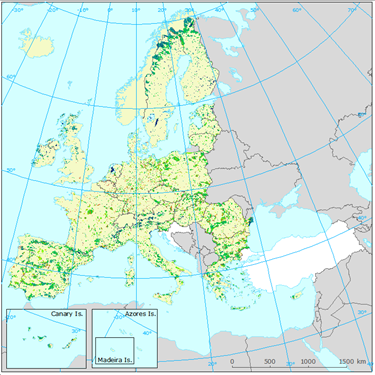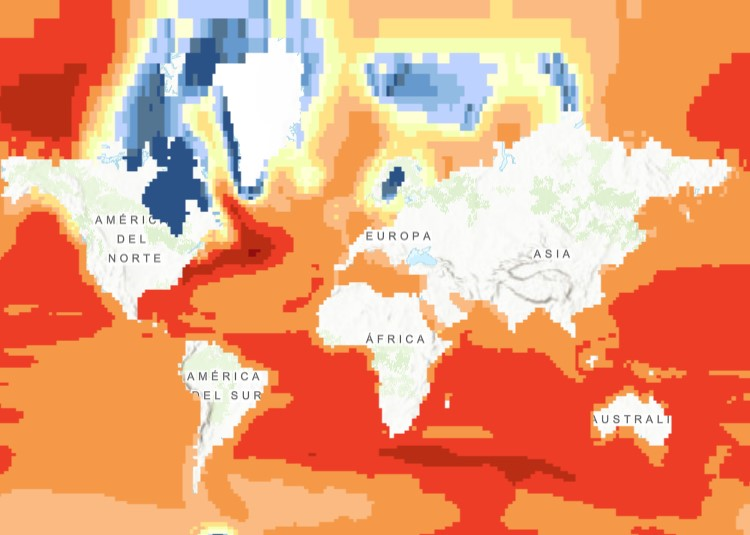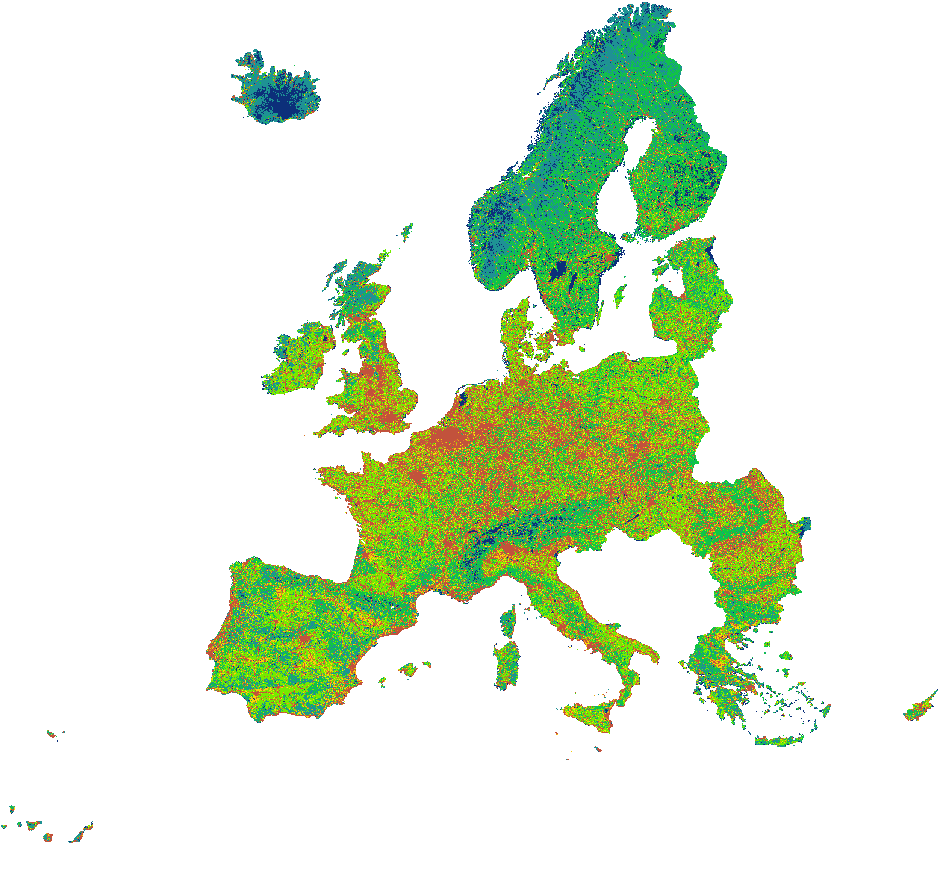notPlanned
Type of resources
Available actions
Topics
INSPIRE themes
Keywords
Contact for the resource
Provided by
Years
Formats
Representation types
Update frequencies
status
Service types
Scale
Resolution
-

Within the European Union, the Environmental Noise Directive (END; 2002/49/EC) defines quiet areas outside cities as those areas delimited by national authorities that are undisturbed by noise from traffic, industry or recreational activities. In this dataset, two datasets has been brought together to visualize how human made noise have an impact on nature protected areas: the Natura2000 dataset and the quietness suitable index dataset. The data set is provided by countries both in Geodatabase and Geopackage formats.
-

Raster data set of built-up and non built-up areas including continuous degree of soil sealing ranging from 0 - 100% in spatial resolution (20 x 20 m).
-

The raster dataset of urban heat island modelling shows the fine-scale (100m pixel size) temperature differences (in degrees Celsius °C) across 100 European cities, depending on the land use, soil sealing, anthropogenic heat flux, vegetation index and climatic variables such as wind speed and incoming solar radiation. In the framework of the Copernicus European Health contract for the Copernicus Climate Change Service (C3S), VITO provided 100m resolution hourly temperature data (2008-2017) for 100 European cities, based on simulations with the urban climate model UrbClim (De Ridder et al., 2015). As the cities vary in size, so do the model domains. They have been defined with the intention to have a more or less constant ratio of urban vs. non-urban pixels (as defined in the CORINE land use map), with a maximum of 400 by 400 pixels (due to computational restraints). From this data set, the average urban heat island intensity is mapped for the summer season (JJA), which is the standard way of working in the scientific literature (e.g. Dosio, 2016). The UHI is calculated by subtracting the rural (non-water) spatial P10 temperature value from the average temperature map. The 100 European cities for the urban simulations were selected based on user requirements within the health community.
-

The raster dataset (1ºx1º) shows the projected change in relative sea level (in metres) in 2081-2100 compared to 1986-2005 for the medium-low emission scenario RCP4.5, based on an ensemble of Coupled Model Intercomparison Project Phase 5 (CMIP5) climate models. Projections consider land movement due to glacial isostatic adjustment but not land subsidence due to human activities. No projections are available for the Black Sea. The dataset has been used as a source for an earlier version of the EEA indicator “Global and European Sea Level”: https://www.eea.europa.eu/data-and-maps/indicators/sea-level-rise-5/assessment.
-

The gridded dataset presents the forest fire danger in Europe for projected climate conditions under the Representative Concentration Pathways (RCP) 4.5 scenario for the temporal range 2071-2100. The forest fire danger is expressed by the average Seasonal Severity Rating index (derived from the Canadian Fire Weather Index System), provided by the Joint Research Centre. The SSR series was computed usign the GCM-RCM run KNMI-RACMO2-ECHAM5 of ENSEMBLES project. Average 2071-2100 SSR levels are provided in the dataset. The dataset contributes to an earlier version of the EEA indicator "Forest fires": https://www.eea.europa.eu/data-and-maps/indicators/forest-fire-danger-2/assessment.
-

This vector dataset presents the extent of areas in European countries directly affected by wildfires (period 2000-2017). This dataset can be used as one of the indications where the danger of wildfires may persist or increase in the future under the changing climate. The dataset is one of the output of the “European Forest Fire Information System-EFFIS” (http://effis.jrc.ec.europa.eu) provided by the Joint Research Centre (JRC). The dataset is also part of the EEA indicator "Forest fires": https://www.eea.europa.eu/data-and-maps/indicators/forest-fire-danger-2/assessment.
-

This dataset represents the observed trend in maximum annual five day consecutive precipitation over Europe, between 1960 and 2015, during the winter season (December, January, February). Heavy precipitation events have become more intense and more frequent in Europe on average, but there are important differences across regions, seasons, time periods, heavy precipitation indices and underlying datasets. Studies generally agree that heavy precipitation has become more intense in northern and north-eastern Europe since the 1950s, even though not all changes are statistically significant. Different studies and indices show diverging trends for south-western and southern Europe. Heavy precipitation may lead to local surface water flooding in cities, therefore should be considered in adaptation planning. This dataset is used also in the EEA Indicator "Heavy precipitation in Europe": https://www.eea.europa.eu/data-and-maps/indicators/precipitation-extremes-in-europe-3/assessment, which in the meantime has been updated.
-

Within the European Union, the Environmental Noise Directive (END, 2002/49/EC) defines quiet areas outside cities as those areas delimited by national authorities that are undisturbed by noise from traffic, industry or recreational activities. The report ‘Quiet areas in Europe: the environment unaffected by noise pollution,’ provides a first mapping assessment of potential quiet areas in Europe’s rural regions. Approximately 18% of Europe’s area can be considered quiet, but 33% is potentially affected by noise pollution, the report finds. This dataset underpins the assessment and is based on the quietness suitability index (QSI), which provides the overview with the highest (QSI=1) and lowest (QSI=0) proportion of potential quiet areas in Europe. The data set is provided in both GDB and TIFF formats.
-

The raster dataset (grid 0.25° x 0.25°) presents the trends in frequency of meteorological droughts between 1950 and 2012. Trends are based on a combination of three different drought indices - SPI (Standard Precipitation Index), SPEI (Standardized Preciptation Evapotranspiration Index) and RDI (Reconnaisance Drought Index) accumulated over 12-month periods. The dataset contributes to an earlier version of the EEA indicator "Meteorological and hydrological droughts": https://www.eea.europa.eu/data-and-maps/indicators/river-flow-drought-2/assessment
-

This gridded dataset presents the projected changes (in percentage) in heavy precipitation in winter season (December, January, February) in Europe, from 1971-2000 to 2071–2100 for the Representative Concentration Pathways (RCP) 8.5 scenario, based on the ensemble mean of different Regional Climate Models (RCMs) nested in different General Circulation Models (GCMs). This dataset is an output of the EURO-CORDEX data, produced in the context of the EURO-CORDEX initiative. EURO-CORDEX is the European branch of the CORDEX initiative, producing ensemble climate simulations based on multiple dynamical and empirical-statistical downscaling models forced by multiple global climate models from the Coupled Model Intercomparison Project Phase 5 (CMIP5). More information about this initiative on: https://www.euro-cordex.net/060374/index.php.en. The dataset has been used in the EEA Indicator "Heavy precipitation in Europe": https://www.eea.europa.eu/data-and-maps/indicators/precipitation-extremes-in-europe-3/assessment, which in the meantime has been updated.
 RUC Geo-Data catalogue
RUC Geo-Data catalogue